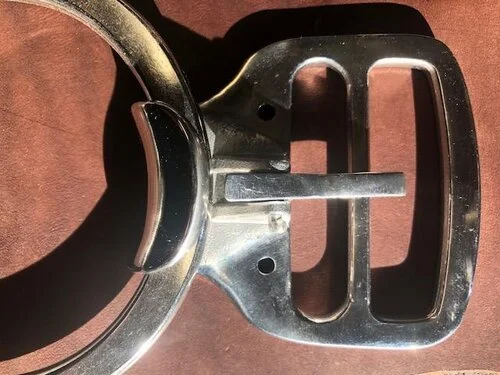Tackaberry Buckle Only
The TACKABERRY BUCKLE as been re-designed for the first time in over 100 years — by COLIN DANGAARD. And now it comes in stainless steel.
Like most other horse equipment this incredible buckle has functioned for over 100 years , as it has always been — traditionally. But Colin found a few characteristics he felt would improve this old buckle. He explains: “
For some reason, the slots have always been curved, which I find without reason of function. So I straightened them. They were also unnecessarily tight on the sides, so I widened them. Also, I put more gap in the slots so they could more easily handle a latigo of good strength.
The old design has always worked excellent with nylon lacing — the long strap that goes up through the girth ring and back through the two slots of the buckle, the lower slot being the final pass. The nylon slips well against the steel, where leather tends to bind, especially if the leather is new and dry. But there are many people who prefer leather latigo — and now they can use this leather more easily with this new design.
I also prefer to use the buckle with a leather facing on the back, especially if you are using a leather latigo, because it eliminates an unnecessary bump caused by folding leather. Nylon lacing must always be stitched, because rivets will eventually pull through nylon.
However, common copper rivets never work loose when installed correctly in leather. I have also lengthened the tongue so it extends more into the hole of the leather latigo, making it more secure. The length of the old tongue works well with nylon, but now it is even more secure..”
The TACKABERRY BUCKLE as been re-designed for the first time in over 100 years — by COLIN DANGAARD. And now it comes in stainless steel.
Like most other horse equipment this incredible buckle has functioned for over 100 years , as it has always been — traditionally. But Colin found a few characteristics he felt would improve this old buckle. He explains: “
For some reason, the slots have always been curved, which I find without reason of function. So I straightened them. They were also unnecessarily tight on the sides, so I widened them. Also, I put more gap in the slots so they could more easily handle a latigo of good strength.
The old design has always worked excellent with nylon lacing — the long strap that goes up through the girth ring and back through the two slots of the buckle, the lower slot being the final pass. The nylon slips well against the steel, where leather tends to bind, especially if the leather is new and dry. But there are many people who prefer leather latigo — and now they can use this leather more easily with this new design.
I also prefer to use the buckle with a leather facing on the back, especially if you are using a leather latigo, because it eliminates an unnecessary bump caused by folding leather. Nylon lacing must always be stitched, because rivets will eventually pull through nylon.
However, common copper rivets never work loose when installed correctly in leather. I have also lengthened the tongue so it extends more into the hole of the leather latigo, making it more secure. The length of the old tongue works well with nylon, but now it is even more secure..”
The TACKABERRY BUCKLE as been re-designed for the first time in over 100 years — by COLIN DANGAARD. And now it comes in stainless steel.
Like most other horse equipment this incredible buckle has functioned for over 100 years , as it has always been — traditionally. But Colin found a few characteristics he felt would improve this old buckle. He explains: “
For some reason, the slots have always been curved, which I find without reason of function. So I straightened them. They were also unnecessarily tight on the sides, so I widened them. Also, I put more gap in the slots so they could more easily handle a latigo of good strength.
The old design has always worked excellent with nylon lacing — the long strap that goes up through the girth ring and back through the two slots of the buckle, the lower slot being the final pass. The nylon slips well against the steel, where leather tends to bind, especially if the leather is new and dry. But there are many people who prefer leather latigo — and now they can use this leather more easily with this new design.
I also prefer to use the buckle with a leather facing on the back, especially if you are using a leather latigo, because it eliminates an unnecessary bump caused by folding leather. Nylon lacing must always be stitched, because rivets will eventually pull through nylon.
However, common copper rivets never work loose when installed correctly in leather. I have also lengthened the tongue so it extends more into the hole of the leather latigo, making it more secure. The length of the old tongue works well with nylon, but now it is even more secure..”








